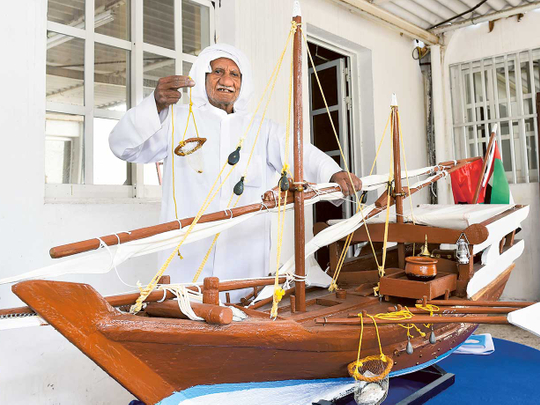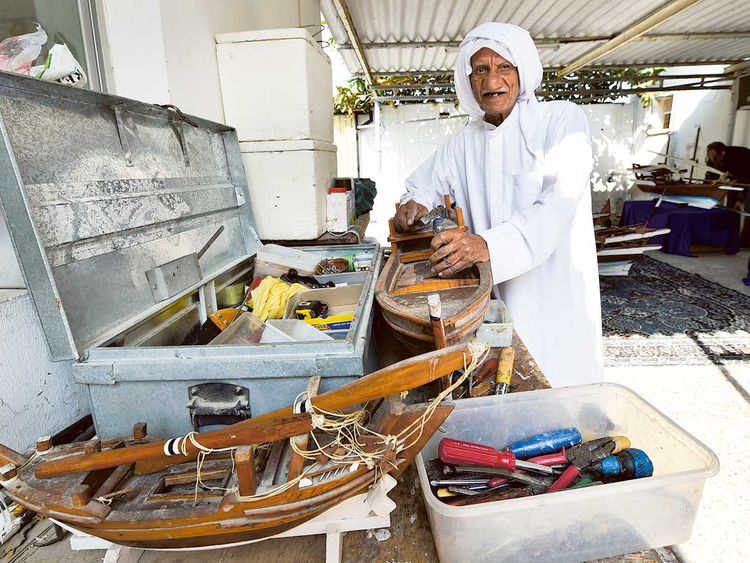
Sharjah: Walking up the street leading to Ebrahim Saleh Hassan Bu Hazza’s house, you can hear a staccato of something striking wood at regular intervals and those familiar with the 89-year-old can tell that he is busy with what he loves doing the most — building scale models of dhows.
Watch: The 89-year-old man whose passion is building dhows
The front door of Bu Hazza’s house opens into a large open space with a display of hand-crafted dhows to the left. Some are placed on tables while others are arranged on a rug on the floor. Towards the end of the yard, a makeshift roof of some kind provides shade over a working space that consists of a table with a number of tools on it. It’s Bu Hazza’s work station.
To an outsider it appears messy but Bu Hazza seems to know exactly where everything is.
A small-built man, his energy levels force you to wonder if he is really nudging his nonagenarian years but the wrinkles on his face make you wonder about his age.
Showing Gulf News his lovingly crafted dhows, Bu Hazza is as excited as a child. “I enjoy this work, I don’t want to have any other job,” he says, as he rifles through his tools looking for something to fuse two parts of wood together. A cassette player on the table plays folk music from a bygone era, songs they would sing on fishing boats in the good old days. As he hammers the pieces of wood together, Bu Hazza occasionally breaks into song himself.
The little dhows are works of exceptional artistry — the volume of detail on each piece is incredible, and the fact that all of it is being achieved with the help of just one good eye is a testimony to Bu Hazza’s prowess.
While crafting his dhows, Bu Hazza does not refer to any drawings or blueprints. Every design appears to be stored in his head. Once he has made up his mind about the type and size of dhow he wants to make, he begins his work.
The dhows are not exactly of the size that suggest they can be picked up and moved around easily. Many of them are bigger and heavier than him. How does he manage? Bu Hazza simply shrugs in response. “This job is difficult; if you don’t like it, you cannot do it. It is true of any job,” he says.
A few days back, he says, he fell attempting to move one of his creations and it has left him with a sore leg; he rubs the leg occasionally to relieve the pain.
Having been a pearl diver based in Bahrain for most of his life, his love for Sharjah would see him return to the emirate every time he got a chance.
The idea of building his own mini dhows was born when he saw a man carving a little dhow in Bahrain. After studying the man’s craft for a few days, he began to improve his own knowledge about them and soon built his first dhows experimenting with different types of wood. He decided to first master building the dhow’s base (foundation as he calls it).
From that point on, all his spare time was taken up building the little boats. And now, just a year short of turning 90, Bu Hazza cannot remember when exactly he began building them full-time but he knows he has been doing it for a long time.
His memory is hazy about when he moved to Bahrain (“in my teens perhaps”), how long he stayed there or even how old his children are. The only thing he recalls with clarity is the death of his wife 10 years ago. It’s the reason why he now lives alone in the small house in Sharjah, he says.
He did several different jobs but eventually settled on pearl diving. “Diving is better than any other job,” he says. He spent years mastering pearl diving and is happy to share his knowledge with anyone who wishes to learn from him.
His passion for pearl diving is evident in the way he brings alive the details — aspects such as ankle weights, fishing nets, coffee jugs, even a treasure box for the pearls — things that are reflected on his dhows as engravings.
“We had to tie a weight to our leg to go down under the water. We then used our hands to find the oysters. We didn’t have goggles or anything, we just used our hands. Then we put what we found into the nets and they were lifted on to the boats,” he explains, pointing to the carvings on the dhows.
He employs the help of a local carpenter to make the more complex dhow body parts and then puts them together, painstakingly adding each detail, before applying the finishing touch — the paint job.
When a dhow is complete, he either sells it or gifts it to someone he believes is deserving of such a beautiful gift.
He has passed on his knowledge to three of his 12 children and hopes to be able to teach other people, specially young people, about dhows so the tradition can live on. “If anybody would like to work with me, no problem,” he says.
Bu Hazza hopes to continue making his dhows as long as he can. Staying unoccupied, he says, is bad for health.













